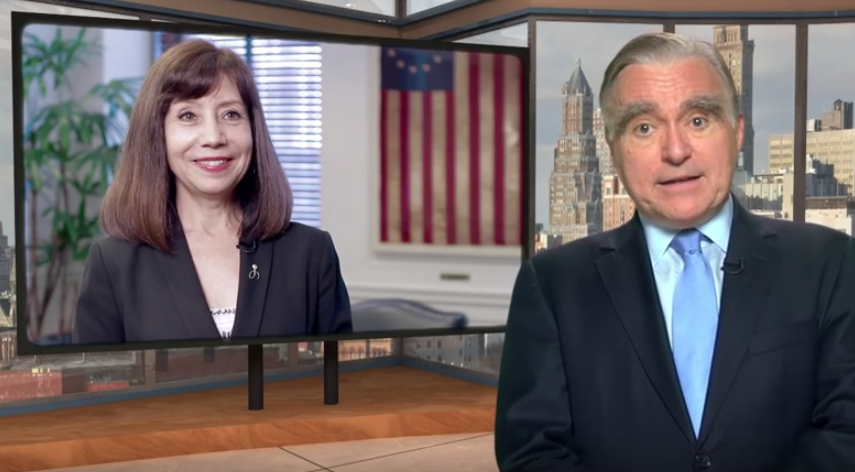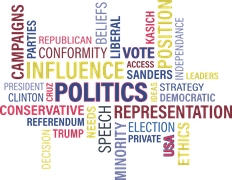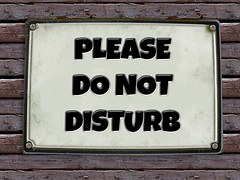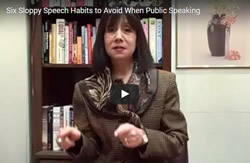If you’ve ever been called a motor mouth you could have a communication problem. You’re never at a loss for words. But when you speed up people will lose part of the message. To make sure this doesn’t happen to you here are some tips to slow you down.
People speak fast for a variety of reasons. It could be geographic. People from the New York metro area tend to speak faster than people from the South. Another reason is nervousness or stress. Increased stress could be the reason for a more rapid rate. Are people not understanding you because your rate is too fast or because the words are not clear? Either way, slowing down will increase your clarity.
The first step is self awareness.
Begin by taping yourself during a normal conversation and be sure to get the other person’s permission. Listen for speed and clarity. Most people speak at a rate of 125 words per minute. The brain can process twice as fast. Develop an awareness of those situations when you speed up. Is it during oral exams? On the telephone? When you’re rushing to class? At a sales call?
The second step is behavior change.
- Practice deep breathing exercises to slow you down in the morning. Meditation and breathing are a healthy way to start your day and will help to calm you down. You can find exercises in Knockout Presentations in chapters 2and 3.
- Practice the pause. Use the beat method. Count two beats at the end of every sentence. For example, Today is Monday (1,2) Tomorrow will be Tuesday (1,2) The problem is usually not saying the words too fast but not putting stops at the end of a sentence. People need a few seconds to process what was just said. (And you need to come up for air)
- Read with rhythm. Practice reading poetry. It has a natural rhythm with built in pauses. Pause for a comma, and use a longer pause at the end of a verse. A few good practice poems are the Twenty third Psalm from the Bible, The Charge of the Light Brigade, by Alfred Lord Tennyson or the opening passage from A Tale of Two Cities by Charles Dickins.
- Listen more. Instead of rattling on, make a statement and ask for a response. “Does that make sense?” ” How does that sound?” are a few ways you can dialogue instead of talking at people.
The third step is self-monitoring.
- Use the buddy system. Have a friend give you feedback when you start to speed up.
- Let others in on your secret. Tell them you’re working on slowing your speech and would like to know if you spoke slowly enough.
- Create job aids. Write the word PAUSE on a post-it. Place the paper on your computer, the telephone, and your date book to serve as a reminder.
To increase credibility, confidence, and clarity, slow down your speed talking.


 What do today's business presenters have in common with television anchors? They both have broadcasting skills. With
What do today's business presenters have in common with television anchors? They both have broadcasting skills. With  It was round two for Hillary Clinton and Donald Trump at the second presidential debate held at Washington University in St. Louis.
The atmosphere was tense as evidenced by the candidates' refusal to shake hands. But while the focus is supposed to be on the candidates, they were upstaged by Martha Raddatz, who co-moderated with Anderson Cooper. Where are the good moderators? It's been a challenge to respect the facilitators in these debates because they don't seem to understand the role of a moderator. Here are some guidelines for being an effective moderator:
It was round two for Hillary Clinton and Donald Trump at the second presidential debate held at Washington University in St. Louis.
The atmosphere was tense as evidenced by the candidates' refusal to shake hands. But while the focus is supposed to be on the candidates, they were upstaged by Martha Raddatz, who co-moderated with Anderson Cooper. Where are the good moderators? It's been a challenge to respect the facilitators in these debates because they don't seem to understand the role of a moderator. Here are some guidelines for being an effective moderator:

 What do you do when a loved one dies and you're the person to give the eulogy? Last weekend I attended the memorial service of my friend, Linda who lost her battle to lung cancer at the age of 63.
Memorial services are usually bittersweet. The service was beautifully inspiring and sad at the same time. The tributes from her sorority sisters gave an insight into her personality and the reader of her legacy left a powerful impression of Linda's contribution of the world. The soloist sang Linda's favorite song with feeling and his voice filled up the room with love.
What do you do when a loved one dies and you're the person to give the eulogy? Last weekend I attended the memorial service of my friend, Linda who lost her battle to lung cancer at the age of 63.
Memorial services are usually bittersweet. The service was beautifully inspiring and sad at the same time. The tributes from her sorority sisters gave an insight into her personality and the reader of her legacy left a powerful impression of Linda's contribution of the world. The soloist sang Linda's favorite song with feeling and his voice filled up the room with love. I went to the supermarket to pick up a few items. Not wanting to wait in line, I found a cashier who was without customers. She had her back turned as she was shuffling a deck of coupons. I approached her and stood there expecting her to stop what she was doing to serve me. She did not. She continued to organize the coupons and never said a word to me or attempted to make eye contact. She placed a rubber band around the coupons, put them in the drawer and without saying a word, started to ring up the two items.
I went to the supermarket to pick up a few items. Not wanting to wait in line, I found a cashier who was without customers. She had her back turned as she was shuffling a deck of coupons. I approached her and stood there expecting her to stop what she was doing to serve me. She did not. She continued to organize the coupons and never said a word to me or attempted to make eye contact. She placed a rubber band around the coupons, put them in the drawer and without saying a word, started to ring up the two items.
 It's the Dog Days of August and public speaking is going to the dogs - in a good way. Animals, especially dogs, have been used in pet therapy programs for years. Research shows that pets can help lower blood pressure, and reduce anxiety. Bonnie Auslander, who specializes in
It's the Dog Days of August and public speaking is going to the dogs - in a good way. Animals, especially dogs, have been used in pet therapy programs for years. Research shows that pets can help lower blood pressure, and reduce anxiety. Bonnie Auslander, who specializes in 



 Last month I had the good fortune to hear Kevin O’Leary of Shark Tank speak at a networking event. Unlike typical celebrity events, this venue was intimate, allowing contact with Mr O’Leary and even a photo opp.
After drinks and hors d’oeuvres, we gathered into a small theater-like room to hear him speak. His speaking approach surprised me and I found it refreshing. Instead of the usual PowerPoint, or main stage podium presentation, Mr O’Leary entered the room in an unassuming manner yet strongly communicated
Last month I had the good fortune to hear Kevin O’Leary of Shark Tank speak at a networking event. Unlike typical celebrity events, this venue was intimate, allowing contact with Mr O’Leary and even a photo opp.
After drinks and hors d’oeuvres, we gathered into a small theater-like room to hear him speak. His speaking approach surprised me and I found it refreshing. Instead of the usual PowerPoint, or main stage podium presentation, Mr O’Leary entered the room in an unassuming manner yet strongly communicated 
 Could a top presenter bomb in the virtual world?
Your keynotes get rave reviews. Your training seminars are highly rated. Your reputation as a
Could a top presenter bomb in the virtual world?
Your keynotes get rave reviews. Your training seminars are highly rated. Your reputation as a  There are no boring topics-only boring speakers. Just about every audience and coaching client has heard me make that statement about
There are no boring topics-only boring speakers. Just about every audience and coaching client has heard me make that statement about 
 DiResta Communications Recognizes International Women’s Day with Re-Launch of “Give Fear the Finger”
DiResta Communications Recognizes International Women’s Day with Re-Launch of “Give Fear the Finger”